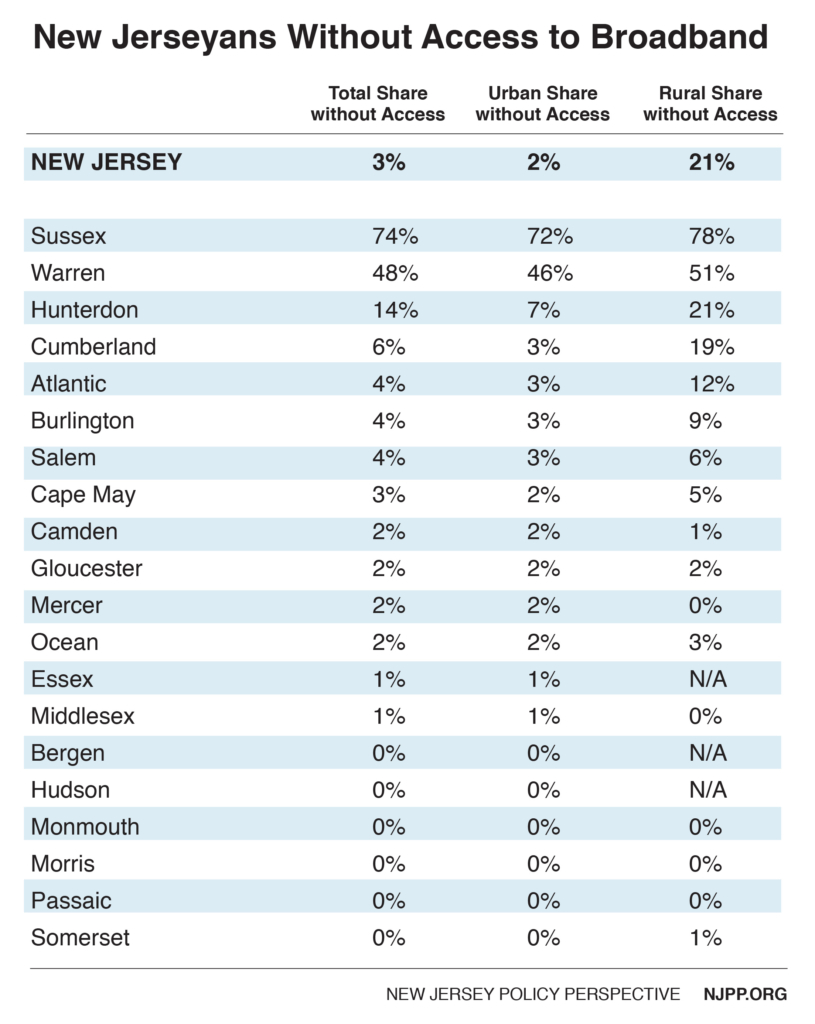Nearly 300,000 New Jerseyans are estimated to lack access to broadband service, particularly in rural parts of the state, hampering their ability to fully participate in the state’s economy.
 While New Jersey fares better than the nation as a whole on broadband access – just 3 percent of Garden State residents lack access, compared to 10 percent of Americans overall – access to this vital service should be universal here, in the country’s most densely populated state.
While New Jersey fares better than the nation as a whole on broadband access – just 3 percent of Garden State residents lack access, compared to 10 percent of Americans overall – access to this vital service should be universal here, in the country’s most densely populated state.
What’s more, while New Jersey’s overall broadband penetration is relatively high, access drops dramatically in the state’s rural areas, with more than 1 in 5 rural New Jerseyans (21 percent) lacking access.[1] (See Appendix for full breakdown.)
It’s worth noting that the estimates of broadband access used here likely overestimate New Jerseyans’ access, as they do not reflect certain factors – like the widespread use of fiber deployment waiver requests from telecom corporations – that are keeping additional New Jersey households from having access to broadband. We’ll have more on that in a forthcoming report.
And of course, access is one thing – adoption is another. While only an estimated 3 percent of New Jerseyans lack access to high-speed internet, an estimated 15 percent of New Jerseyans live in a household without broadband.[2] And just because someone has access to broadband doesn’t mean they have a choice of carrier. While recent data is not available for New Jersey, nationally, three-quarters of American homes have no competitive choice for high-speed broadband.[3]
Nationally, far more low-income households live without broadband (59 percent of households with incomes under $20,000) than higher-income households (10 percent of households with incomes over $100,000). Black and Hispanic families also live without broadband at much higher rates (50 percent and 46 percent, respectively) than white families (28 percent). Research finds that cost is a significant barrier to home broadband service for many low-income families; among those without broadband, 33 percent cite the monthly cost of service as the main reason, with an additional 10 percent citing the cost of a computer as their main reason.[4]
High-speed internet has in many ways become central to participation in society, and broadband has morphed in recent years from a luxury to a necessity. Large institutions – including major employers, public school districts and government agencies – increasingly assume their customers have access, and are adjusting their services accordingly.
While this change usually makes life easier for those with access to broadband, it can make life additionally difficult for those without access, as these same institutions cut back on their offline offerings. And for low-income people, other obstacles – like reliance on public transportation, inflexible or unpredictable work schedules and strained child care resources – make it even more difficult to fully participate in society and the economy without broadband access.
More access to affordable broadband could improve New Jerseyans’ economic opportunities, education and access to important government services. The existence of this digital divide continues to exacerbate the negative effects of income inequality, which is at record levels in New Jersey.[5] Closing this divide is an essential step to create equal opportunities for all.
Employment: In an era when many employers are using only online applications – including over 80 percent of Fortune 500 companies and the state and federal governments[6] – it’s no surprise that high-speed internet is an important tool for job seekers. Among Americans who have looked for work in the last two years, nearly 8 in 10 (79 percent) used online resources in their most recent job search, according to a 2015 survey.[7] Unemployed people using the web for job searches have been found to obtain jobs about 25 percent faster than similar candidates who didn’t search online.[8] And access to broadband doesn’t just help the unemployed find jobs – it can help the already-employed find better jobs.
Education: As any parent can attest, homework increasingly demands the use of the internet. Nearly all (94 percent) school districts serving low-income populations reported in 2007 that at least “some of their teachers assign internet-based homework.”[9] And among high schoolers surveyed in a more recent study, 73 percent “are required to use the internet to complete homework” daily or every few days and another 24 percent have to do so, but less frequently.[10] But 1 in 4 households with incomes under $50,000 and school-age children lack high-speed internet at home, placing major barriers to these children’s educational attainment.[11]
Access to Government Services: Access to broadband makes it easier for families to obtain information about, and apply for, most government public assistance programs.[12] New Jersey, for example, has online applications for all of the five major state-administered programs for low-income people (SNAP food assistance, Medicaid, TANF, CHIP and child care).[13] In addition to the greater difficulty that is involved in applying in person (such as missing work) or obtaining assistance over the phone, there are other disadvantages in not being able to apply for benefits online. Public benefit programs commonly make assistance effective based on the date of application; people who have to call to get an application mailed to them, complete it, and mail it back may have to wait longer for aid and lose a week or more of benefits.[14]
Appendix
Endnotes
[1] Federal Communications Commission, 2016 Broadband Progress Report, January 2016.
[2] US Census Bureau, Computer and Internet Use in the United States: 2013, November 2014.
[3] Federal Communications Commission Chairman Tom Wheeler, The Facts and Future of Broadband Competition, September 2014.
[4] Pew Research Center, Home Broadband 2015, December 2015.
[5] Economic Policy Institute, The Increasingly Unequal States of America, January 2015.
[6] Federal Communications Commission, Broadband Adoption Key to Jobs and Education, October 2011.
[7] Pew Research Center, Searching for Work in the Digital Era, November 2015.
[8] The Economic Journal, Is Internet Job Search Still Ineffective?, December 2014.
[9] National School Boards Association, Creating & Connecting: Research and Guidelines on Online Social – and Educational – Networking, July 2007.
[10] Hispanic Heritage Foundation, myCollegeOptions, and Family Online Safety Institute, Taking the Pulse of the High School Student Experience in America, April 2015.
[11] Pew Research Center, The Numbers Behind the Broadband ‘Homework Gap’, April 2015.
[12] US Government Accountability Office, Broadband: Intended Outcomes and Effectiveness of Efforts to Address Adoption Barriers Are Unclear, June 2015.
[13] Center on Budget and Policy Priorities, Online Services for Key Low-Income Benefit Programs, March 2016.
[14] Center on Budget and Policy Priorities, FCC Broadband Initiative Could Reduce Barriers to Low-Income Americans’ Advancement and Promote Opportunity, September 2015.


